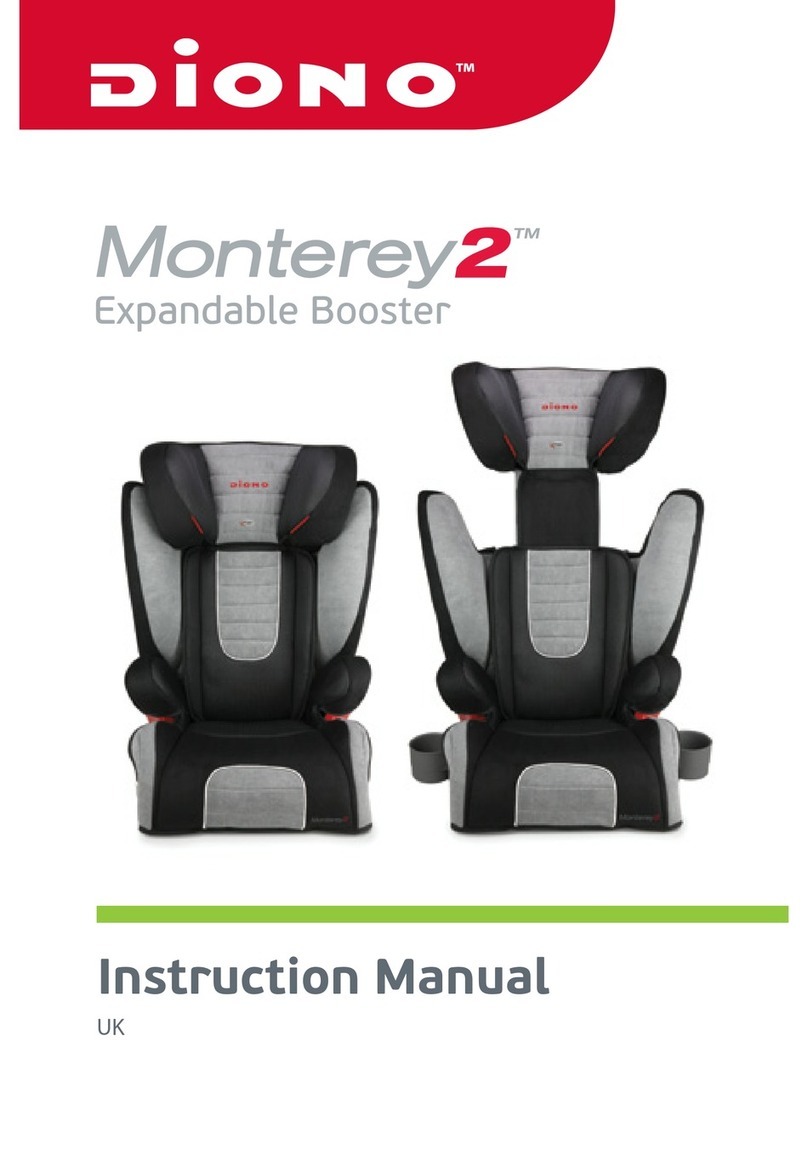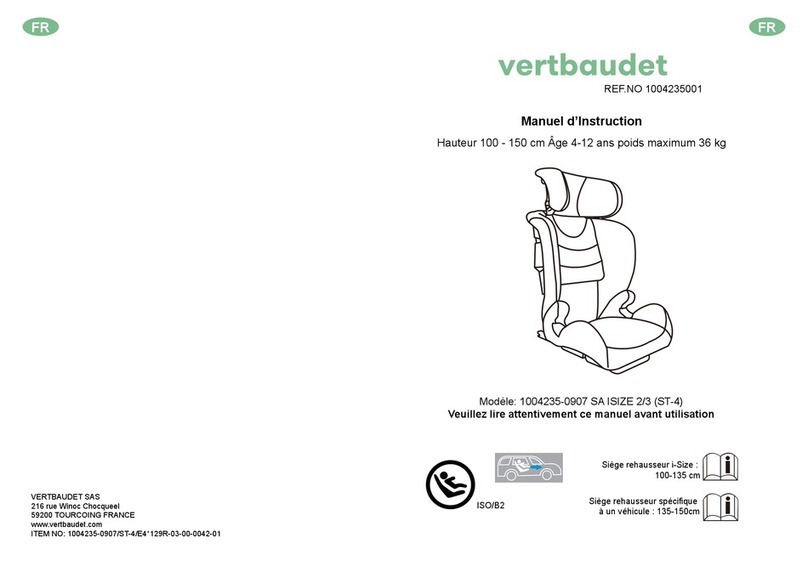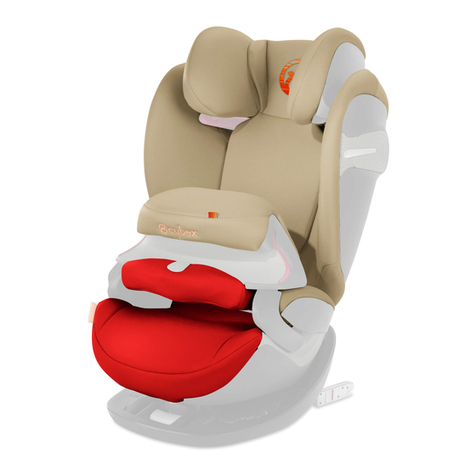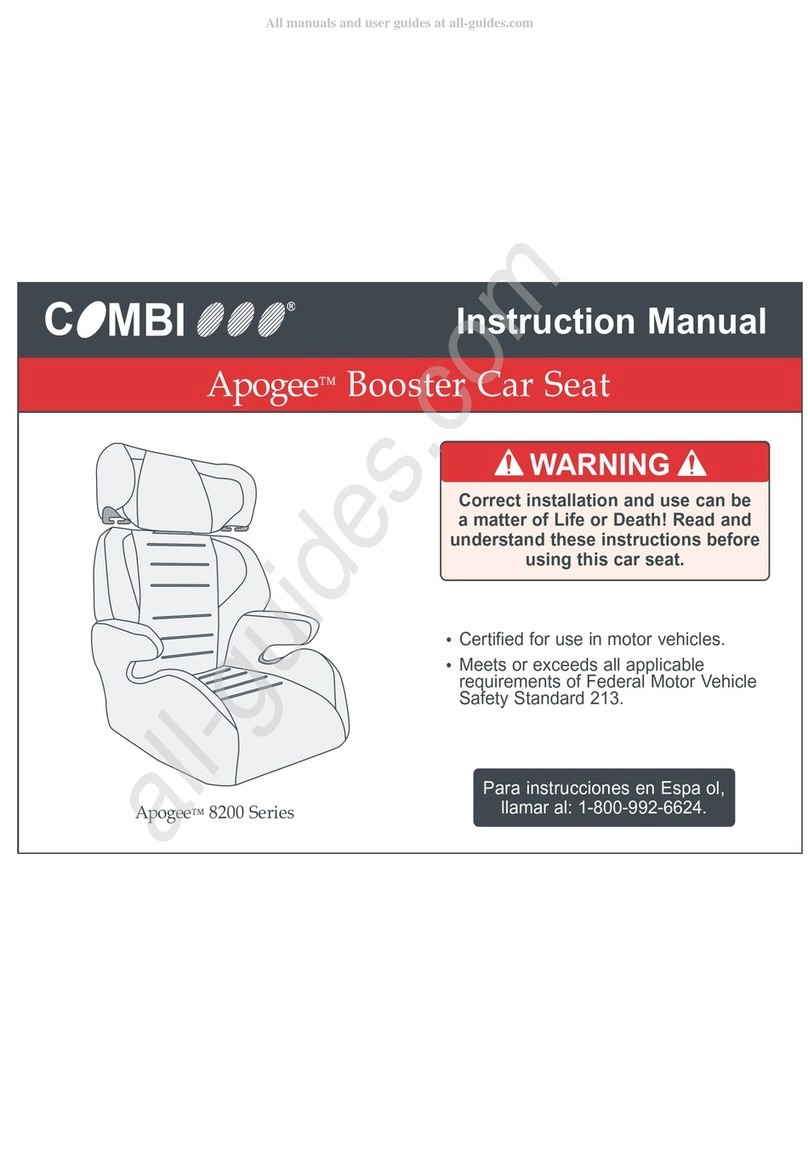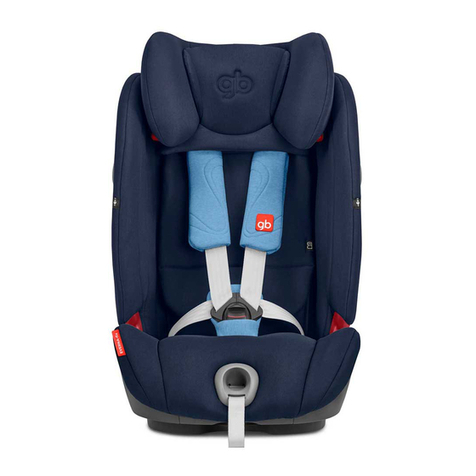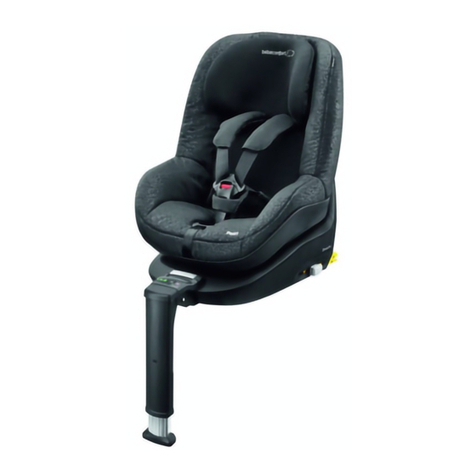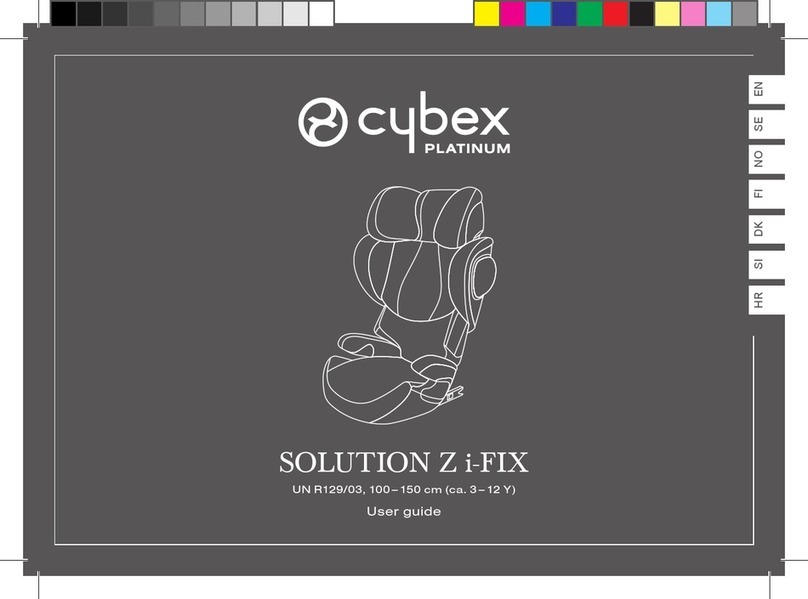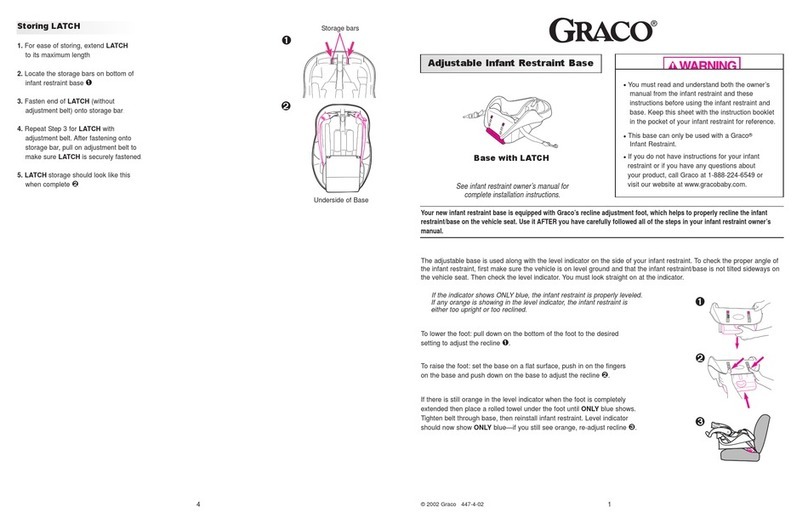Mami ECE GROUP II Operator's manual

PL 1
EBES
PL
EN
INSTRUKCJA | MANUAL | HANDBUCH
www.momi.store
Simply together
FOTELIK SAMOCHODOWY
CAR SEAT
KINDERSITZ
QUICK FIX
ECE GROUP II+III
15 KG- 36 KG

3–11
12-16
Simply together
PL
EN
www.momi.store
17–22

PL 3
1.
2.

4 PL
3.
4.
5.

PL 5
6.
7.
8.

6 PL
9.
10.
Części składowe produktu 1. Zagłówek. 2. oparcie. 3. Prowadnica pasa biodrowego. 4. Uchwyt na
kubek 5. Przycisk zwalniania ISOFIX. 6. Podłokietnik. 7. Boczna ochrona. 8. Prowadnica pasa na-
ramiennego 9. Regulacja wysokości zagłówka. 10. Eco skóra. 11. Obudowa fotelika 12. Podstawa
fotelika. 13. Zaczep ISOFIX.
Szanowny Kliencie,
Bardzo dziękujemy za zakup fotelika samochodowego MoMi QUICK FIX. Mamy nadzieję, że zakupiony
produkt spełnia Twoje oczekiwania.
W przypadku dodatkowych pytańzapraszamy do kontaktu za pośrednictwem strony internetowej
www.momi.store
W trosce o bezpieczeństwo dzieci prosimy o precyzyjne zapoznanie sięz instrukcjąobsługi oraz o
stosowanie siędo jej zaleceńw celu bezpiecznego korzystania z produktu. Obowiązkowo osobądo-
konującąmontażu musi byćosoba dorosła, która wykorzysta wszystkie elementy składowe produktu
zgodnie z instrukcjąobsługi i ich przeznaczeniem aby nie dopuścićdo obrażeń.

PL 7
WAŻNE !
PRZECZYTAJ UWAŻNIE I ZACHOWAJ NA PRZYSZŁOŚĆ JAKO ODNIESIENIE
Pamiętaj by usunąć i wyrzucićwszystkie elementy opakowania, które były załączone do produktu,
tak aby nie pozostały w zasięgu dziecka (m.in. elementy kartonu, plastikowe folie itp.). Mogłoby to
spowodowaćryzyko krzywdy, np. zadławienie dziecka, uduszenie dziecka. Instrukcjęzaleca siędo za-
chowania na przyszłość aby w razie konieczności przeczytaćjak postępowaćw przypadku zagrożenia,
bądźodpowiedniej konserwacji.
Zastosowanie
Fotelik jest przeznaczony dla dzieci w grupie wagowej II i III, czyli o wadze pomiędzy 15 kg a 36 kg (od
ok. 3 do 12 roku życia)
II grupa wagowa: 15 kg- 25 kg
III grupa wagowa: 22 kg- 36 kg
Dziecko należy zapinaćprzy użyciu 3-punktowych pasów bezpieczeństwa dla dorosłych lub 3-punk-
towych pasów bezpieczeństwa dla dorosłych z dodatkowymi elementami mocującymi (system moco-
wania ISOFIX). Wymagane zapoznanie sięz instrukcjąobsługi producenta pojazdu.
Ten fotelik samochodowy należy do kategorii „uniwersalne”. Produkt jest zatwierdzony zgodnie z re-
gulacjąnr 44.04, do ogólnego zastosowania w pojazdach i będzie pasowałdo większości, ale nie do
wszystkich siedzeńsamochodowych.
Dopasowanie jest prawidłowe jeśli producent pojazdu zadeklarowałw instrukcji pojazdu, że pojazd jest
w stanie zaakceptować„uniwersalne” urządzenie przytrzymujące dla dzieci w tej grupie wiekowej.
Fotelik można zainstalowaćjedynie wówczas, gdy homologowane pojazdy wyposażone sąw 3-punk-
towe pasy bezpieczeństwa, które uzyskały homologacje zgodnie z regulaminem ONZ/EKG nr 16 lub
innymi równoważnymi normami.
Środki ostrożności
W trosce o bezpieczeństwo twojego dziecka prosimy o przeczytanie niniejszej instrukcji obsługi oraz o
stosowanie siędo jej zaleceńw celu bezpiecznego korzystania z fotelika. Wiele łatwych do uniknięcia
urazów powodowanych jest przez niewłaściwe użytkowanie produktu.
• Fotelik należy używaćtylko i wyłącznie w pozycji przodem do kierunku jazdy.
• Dziecko musi byćobowiązkowo przypięte pasami bezpieczeństwa.
• Nie wolno umieszczaćfotelika dziecięcego na siedzeniach wyposażonych w aktywnąprzedniąpo-
duszkępowietrzną, gdyżmoże to stwarzaćryzyko niebezpieczeństwa. Nie dotyczy to bocznych
poduszek powietrznych.
• W przypadku zamontowania fotelika dziecięcego na przednim siedzeniu, należy wyłączyćpoduszę
powietrznąi przesunąć fotel pasażera jak najbardziej do tyłu (sprawdźinstrukcjęobsługi swojego
samochodu)
• Zaleca sięmontowanie fotelika samochodowego jedynie na tylnych siedzeniach samochodu.
• Wskazówki na temat przydatności siedzenia samochodu do użycia z fotelikiem można znaleźć w
podręczniku użytkowania samochodu.
• Fotelik można instalowaćjedynie wówczas, gdy homologowane pojazdy wyposażone sąw trzy-
punktowe, wyposażone w zwijacz pasy bezpieczeństwa, które uzyskały homologacjęzgodnie z
regulaminem ONZ/EKG nr 16 lub innymi równoważnymi normami.
• Pamiętaj aby wszelkie pasy mocujące fotelik do pojazdu były napięte; pasy przytrzymujące dziecko
były dopasowane do budowy jego ciała oraz by szelki/pasy nie były poskręcane

8 PL
• Fotelik należy wymienićna nowy, jeśli zostałon poddany gwałtownym obciążeniom występującym
podczas wypadku drogowego.
• Fotelik należy chronićprzed bezpośrednim działaniem słońca, w przeciwnym razie nagrzane ele-
menty mogąoparzyćdziecko
• Nie wolno poddawaćfotelika żadnym modyfikacjom
• Nigdy nie pozostawiaj dziecka bez opieki.
• Zawsze przypinaj dziecko pasami bezpieczeństwa.
• Zwróćuwagęna to, aby bagaże i inne przedmioty były wystarczająco zabezpieczone, w szczególno-
ści na półce pod tylnąszybą, gdyżw razie zderzenia mogąone spowodowaćuraz, obrażenia ciała a
nawet śmierć.
• Fotelik nie może byćużywany bez tapicerki
• Nie należy stosowaćzamiennych tapicerek, ani jakichkolwiek innych części innych niżte, reko-
mendowane przez producenta, ponieważstanowiąone integralnączęść systemu bezpieczeństwa
fotelika
• Zaleca sięzachowanie instrukcji obsługi fotelika i przechowywanie jej w łatwo dostępnym miejscu
w samochodzie, przez cały okres użytkowania produktu
• Nie należy stosowaćinnych punktów mocowań, niżpunkty opisane w instrukcji i oznaczone na
foteliku dla dzieci.
• Wszystkie twarde elementy oraz plastikowe części fotelika dla dzieci należy umieścići zainstalować
w taki sposób, by w normalnych warunkach eksploatacji pojazdu nie mogły zostaćuwięzione przez
przesuwane siedzenie lub drzwi pojazdu.
• Regularnie sprawdzaj stan techniczny pasów, szczególnąuwagęzwróćna punkty mocowania,
szwy, oraz elementy regulujące.
• Zaprzestańkorzystaćz fotelika dziecięcego , jeżeli, któreśz jego części uległy uszkodzeniu lub ob-
luzowaniu po wypadku.
• W przypadku gdy wystąpi sytuacja awaryjna, ważne jest szybkie rozpięcie pasów bezpieczeństwa.
• Pamiętaj, że przycisk zwalniający szelki nie jest w pełni zabezpieczony, dlatego dopilnuj, aby twoje
dziecko wiedziało, że nie wolno bawićsięklamrą.
• Nie korzystaj z fotelika w domu. Nie jest przystosowany do użytku domowego i należy go używać
jedynie podczas podróży samochodem.
• Tyłoparcia fotelika dziecięcego musi opieraćsiępłasko o oparcie fotela samochodu. Należy przy
tym zwrócićuwagę, aby poprzez zagłówek samochodowy nie doszło do powstania niechcianego
odstępu między oparciem fotelika a oparciem fotela pojazdu samochodowego, w przypadku gdyby
doszło do wystąpienia luzów, należy zdemontowaćzagłówek.
• Klamra pasa bezpieczeństwa dla dorosłych nie może znajdowaćsięzbyt blisko spodu podłokietnika
fotelika dziecięcego, w przypadku wątpliwości tego punktu, skontaktuj sięz producentem fotelika.
• Należy dawaćdziecku dobry przykład i zawsze przypinaćsiępasami. Zagrożenie dla dziecka może
stanowićrównieżosoba dorosła, która nie jest przypięta pasami bezpieczeństwa.
• Przed każdąpodróżą upewnij się, że fotelik jest poprawnie przymocowany.
• Fotelik należy zabezpieczyćtakże wtedy, gdy nie jest użytkowany. Niezamocowany fotelik może
nawet przy awaryjnym hamowaniu spowodowaćobrażenia ciała pasażerów.

9EN
Umiejscowienie fotelika dziecięcego w pojeździe.
Ważne: pasy bezpieczeństwa
Fotelik można stosowaćz 3-punktowym pasem bezpieczeństwa, zatwierdzonym zgodnie z regulami-
nem ONZ/EKG nr 16 lub innymi równoważnymi normami. (Patrz rys. 10)
Wysokość zagłówka
Ważne jest by zagłówek byłprawidłowo ustawiony. Zapewnia to optymalne rozmieszczenie części
naramiennej pasa samochodowego i daje dziecku ochronęoraz komfort.
UWAGA Pas naramienny powinien przejść między ramieniem a szyjądziecka, zagłówek powinien być
dobrze dopasowany do głowy dziecka.
W celu regulacji zagłówka, złap za uchwyt regulujący (9), który znajduje sięz tyłu zagłówka i pociągnij
go delikatnie w górę. Zagłówek zostanie odblokowany.
INSTALACJA SKIEROWANA DO PRZODU
Dozwolona jest
tylko instalacja
skierowana
do przodu
W kierunku jazdy TAK
Przeciwnie do kierunku jazdy NIE
Z 2-punktowym pasem NIE
Zastosowanie 2-punktowego pasa bezpieczeństwa znacznie zwiększa ryzyko urazów
dziecka w razie wypadku
Z 3-punktowym pasem TAK
Pas bezpieczeństwa musi byćzatwierdzony zgodnie z ECE16 lub porównywalną
normą(patrz etykieta testowa na pasku z literą“E” lub “e” w kółku.)
Z systemem kotwiczenia ISOFIX TAK
Jeśli w samochodzie znajduje sięprzednia poduszka powietrzna: należy przesunąć
siedzenie pasażera daleko w tyłi zapoznaćsięz informacjami w instrukcji obsługi
samochodu
Na przednim siedzeniu pasażera TAK
Nie używaćna siedzeniach pasażera, jeśli samochód jest wyposażony w poduszkę
powietrzną! Przednie siedzenie pasażera może byćużywane z lub bez systemu
ISOFIX stosując te same uwagi, które podano dla ISOFIX (przesunięcie oparcia
siedzenia i odniesienie do instrukcji samochodu)
Na zewnętrznym tylnym siedzeniu TAK
Na środkowym tylnym siedzeniu TAK
Może byćstosowany, jeśli siedzenie pojazdu jest wyposażone w 3-punktowy pas.

10 PL
Można teraz wyregulowaćwysokość zagłówka. Gdy wysokość zostanie wyregulowana, należy puścić
uchwyt regulujący, zagłówek zostanie zablokowany w wybranej pozycji.
Umieść fotelik na siedzeniu pojazdu. Umieść dziecko w foteliku i sprawdźczy wysokość zagłówka
została dobrze dostosowana. Jeśli to konieczne, powtórz czynność regulacji wysokości zagłówka, aż
zostanie osiągnięta optymalna wysokość dla twojego dziecka. (Patrz rys. 1 i 2)
Dopasowanie oparcia
Oparcie fotelika samochodowego, można łatwo dopasowaćdo pozycji fotela pojazdu. Najlepsza ochro-
na jest zapewniona, gdy siedzenie pojazdu znajduje sięw pozycji pionowej (np. w przypadku siedzeń,
które wyposażone sąw regulacjętj. przedni fotel pasażera).
Oparcie fotelika samochodowego jest ruchome, dlatego, możliwe jest dokładne dopasowanie do
płaszczyzny fotela pojazdu. Pochyl oparcie do tyłu, ażznajdzie sięw pozycji przylegającej do siedzenia
pojazdu. (Patrz rys. 3)
Montażfotelika w samochodzie
Zawsze należy sprawdzić, czy:
• wszyscy pasażerowie majązapięte pasy bezpieczeństwa
• fotelik jest zawsze zabezpieczony, nawet, gdy dziecko nie jest w nim przewożone
•
oparcia foteli w pojeździe sązablokowane (zatrzaśnięta jest blokada składanego oparcia tylnego siedzenia)
• wszystkie ciężkie przedmioty i posiadające ostre krawędzie sązabezpieczone (np. na tylnej półce)
Zabezpieczenie pojazdu
Obicia foteli w niektórych pojazdach mogąbyćwykonane z delikatnych materiałów, na których fotelik
może pozostawićślady. Aby zabezpieczyćfotele w samochodzie przed zabrudzeniami i przetarciami
obicia foteli, zalecamy umieścićpod fotelikiem koc, ręcznik lub odpowiednio dostosowanąpodkładkę
pod fotelik.
Instalacja fotelika samochodowego dla dzieci z grupy wagowej II/III za pomocą3- punktowych
pasów bezpieczeństwa pojazdu.
WAŻNE: należy zapoznaćsięz instrukcjąpojazdu, gdzie podano lokalizacjępunktów mocowania oraz
inne niezbędne informacje dotyczące montowania fotelika w samochodzie.
• Wyreguluj zagłówek do wzrostu dziecka zgodnie z punktem „wysokość zagłówka”
• Umieść fotelik dla dzieci na fotelu pojazdu. Upewnij się, czy oparcie fotelika przylega płasko do
oparcia siedzenia pojazdu. Patrz punkt „dopasowanie oparcia”
• Pas naramienny poprowadźprzez czerwonąprowadnicę(8) pod zagłówkiem
• Umieść dziecko w foteliku i poprowadźpas samochodowy z przodu dziecka. Zapnij pas samochodowy
w klamrze, usłyszysz wtedy charakterystyczne „kliknięcie”. Upewnij się, że pasy nie sąposkręcane.
• Pas biodrowy powinien byćumieszczony pod podłokietnikiem przez czerwonąprowadnicępasa
biodrowego (3). Pas naramienny umieszcza sięnad podłokietnikiem.
• UWAGA! Pas naramienny nie powinien byćumieszczony na czerwonej taśmie, pod podłokietnikiem.
Naciągnij pas siedzenia pojazdu, pociągając odcinek pasa biodrowego, następnie odcinek pasa nara-
miennego. Dopilnuj aby pas biodrowy byłrozciągnięty możliwie nisko nad biodrami dziecka, mieściłsię
w prowadnicach oraz żeby byłzapięty klamrą. Pas naramienny powinien przechodzićmiędzy ramie-
niem a szyjądziecka. Upewnij się, że pas nie uciska szyi dziecka. (Patrz rys. 4 i 5)
W razie potrzeby możesz równieżzmienićwysokość zagłówka, gdy fotelik znajduje sięw pojeździe.

PL 11
Instalacja fotelika samochodowego dla dzieci z grupy wagowej II/III za pomocą3-punktowych
pasów bezpieczeństwa pojazdu i dodatkowych zaczepów.
UWAGA Nie każdy samochód wyposażony jest w system mocowania ISOFIX, upewnij się, czy twój
samochód wyposażony jest w ISOFIX, sprawdzając w instrukcji pojazdu, albo u jego producenta.
• Naciśnij przycisk zwalniania systemu ISOFIX (5) znajdujący sięz przodu fotelika i wyciągnij jak naj-
dalej zaczepy ISOFIX z podstawy fotelika. (Patrz rys. 6)
• Chwyćfotelik dwiema rękoma i wsuńoba zaczepy do mocowańw fotelu samochodowym, ażusły-
szysz „kliknięcie” każdego z zaczepów ISOFIX (Patrz rys. 7)
• UWAGA: zaczepy blokujące sąprawidłowo zamocowane tylko wtedy, gdy oba znaczniki przycisków
sącałkowicie zielone.
• Chwyćfotelik w celu sprawdzenia czy jest prawidłowo zamontowany i nie występująluzy. Jeśli się
rusza i jest niestabilny, a zaczepy ISOFIX wysuwająsię, należy powtórzyćwcześniejsze czynności.
• Zapnij dziecko za pomocąpasów bezpieczeństwa pojazdu. Szczegóły opisane sąw punkcie powy-
żej. (Patrz rys. 8)
Demontażfotelika samochodowego (system mocowania ISOFIX)
Naciśnij przycisk zwalniający, który znajduje sięna obu ramionach ISOFIX. Zaczepy zostanązwolnione,
a kolor znaczników zmieni sięna czerwony. Schowaj ramiona ISOFIX z powrotem w podstawęfotelika.
(Patrz rys. 9)
Demontaż/montażpokrowca
Pociągnij delikatnie materiałz tyłu zagłówka, ażzacznie wychodzićze szczeliny, pociągnij i zdejmij do
końca. Powtórz ten krok ściągając pokrowiec z oparcia, siedziska i podłokietników.
W celu montażu pokrowca należy postępowaćw odwrotnej kolejności.
Należy korzystaćtylko i wyłącznie z oryginalnego pokrowca, gdyżjest on integralnym elementem fo-
telika i istotnie wpływa na jego bezpieczeństwo.
UWAGA Nie należy korzystaćz fotelika bez pokrowca.
Czyszczenie fotelika samochodowego
Zabrania sięużywania agresywnych środków czyszczących, ponieważmogąone uszkodzićmateriał
konstrukcyjny fotelika dziecięcego. Czyścićręcznie wodąlub łagodnym mydłem. Można praćw pralce
w programie delikatnym (30C). W przypadku prania w temperaturze powyżej 30C kolory mogązblak-
nąć. Pokrowca nie należy odwirowywać, suszyćw suszarce bębnowej ani stosowaćwybielaczy.
Elementy plastikowe można czyścićwodąz mydłem. Nie należy stosowaćagresywnych środków
czyszczących (jak rozpuszczalniki)
Po wypadku Po wypadku fotelik dziecięcy i pasy bezpieczeństwa należy wymienić. Chociażmogą
wyglądaćna nieuszkodzone, w przypadku kolejnego wypadku, fotelik samochodowy i pasy bezpie-
czeństwa mogąnie zabezpieczaćdziecka tak dobrze, jak powinny.
Gwarancja Producent udziela 6-cio miesięcznej gwarancji na akcesoria dodatkowe dołączone do pro-
duktu oraz 2 letniej gwarancji na produkt bez akcesoriów.
Wyłączenia i ograniczenia gwarancji Jesteśmy odpowiedzialni za jakość naszych produktów. Nasza
gwarancja nie obejmuje wad i uszkodzeńzwiązanych z nieprawidłowym użytkowaniem produktu lub
uszkodzeńmechanicznych.

12
Components of the product
1. Headrest 2. Backrest 3. Lap belt guide 4. Cup holder 5. ISOFIX release button 6. Armrest 7. Side
protection 8. Shoulder belt guide 9. Headrest height adjustment 10. Eco leather 11. Seat casing
12. Seat base 13. ISOFIX anchorages
Dear Customer,
Thank you very much for purchasing the MoMi QUICK FIX child safety seat. We hope that the purcha-
sed product meets your expectations.
Should you have any additional questions, please contact us via www.momi.store
For the sake of children’s safety, please read the manual carefully and follow its recommendations
for safe use of the product. It is compulsory for an adult to use all components of the product during
assembly in accordance with the user manual and their intended use to prevent injuries.
IMPORTANT!
READ CAREFULLY AND KEEP FOR FUTURE REFERENCE
Remember to remove and discard all packaging elements that were included in the product so that
they do not remain within the reach of the child (e.g. cardboard elements, plastic foils, etc.). This could
cause a risk of harm, e.g. child’s choking or suffocation. This manual is recommended for future refe-
rence, if necessary, to read how to proceed in case of danger or appropriate maintenance.
Application
The child safety seat is designed for children in the weight group II and III, i.e. between 15 kg and 36 kg
(from about 3 to 12 years of age)
Weight Group II: 15 kg - 25 kg
Weight Group III: 22 kg - 36 kg
The child shall be fastened, using either 3-point adult safety belts or 3-point adult safety belts with ad-
ditional anchorages (ISOFIX anchorage system). Please refer to the vehicle manufacturer’s manual.
This car seat belongs to the “universal” category. The product is approved according to regulation
44.04, for general use in vehicles and will fit most, but not all car seats.
The fit is correct if the vehicle manufacturer has declared in the vehicle manual that the vehicle is
capable of accepting a “universal” child safety seat for that age group.
The seat may only be installed if the approved vehicles are fitted with 3-point belts that have been
approved according to UN/ECE Regulation No. 16 or other equivalent standards.
Precautions
For the sake of your child’s safety, please read this manual carefully and follow its recommendations
for safe use of the car seat. Many avoidable injuries are caused by misuse of the product.
• Only use the seat in a forward-facing position.
• The child must wear a seat belt.
• Do not place a child safety seat on seats fitted with an active front airbag, as this may present a
hazard. This does not apply to side airbags.
• If the child safety seat is installed in the front seat, deactivate the airbag and move the passenger
seat as far back as possible (check your car instructions manual)
• We recommended installing the child safety seat only in the rear seats of the car.
• Please refer to the car manual for instructions on how to use the child safety seat on the car seat.
EN

13
• The child safety seat may be installed only if the approved vehicles are fitted with three-point safe-
ty belts retractor approved according to UN/ECE Regulation No. 16 or other equivalent standards.
• Remember that belts that attach the child safety seat to the vehicle must be tight; the child restra-
int belts must fit the child’s body structure and the harness/belt must not be twisted
• Replace the child safety seat if it has been subjected to severe stress during a road accident.
• Protect the child safety seat from direct sunlight, otherwise hot objects can burn the child
• Do not modify the child safety seat
• Do not leave your child unattended.
• Always fasten your child’s seat belt.
• Make sure that luggage and other objects are sufficiently protected, especially on the shelf un-
derneath the rear window, as they can cause injury, bodily harm or even death in the event of a
collision.
• The child safety seat cannot be used without upholstery
• Do not use replacement upholstery or any part other than that recommended by the manufactu-
rer, as it is an integral part of the child safety seat
• Keep the child safety seat manual and store it in an easily accessible place in the car for the entire
lifetime of the product
• Do not use other anchorage points than those described in the manual and marked on the child
safety seat.
• All rigid components and plastic parts of the child safety seat must be positioned and installed in
such a way that they cannot become trapped by the sliding car seat or the vehicle door under nor-
mal conditions of use.
• Regularly check the condition of the belts, paying particular attention to the anchorage points, se-
ams, and adjustment elements.
• Stop using the child safety seat if any of its parts has been damaged or loosened after the acci-
dent.
• In case of an emergency, quickly unfasten the safety belt.
• Remember that the harness release button is not fully secured, so make sure your child knows that
playing with the buckle is forbidden.
• Don’t use the child safety seat at home. It is not suitable for home use and should only be used
when travelling by car.
• The back of the child safety seat must rest flat against the back of the car seat. Ensure that there is
no unwanted gap between the back of the child safety seat and the car seat back; if there is a gap,
remove the headrest.
• The adult safety belt buckle must not be too close to the armrest of the child safety seat; if in doubt,
contact the child safety seat manufacturer.
• Set a good example for your child and always fasten your seat belts. An adult who is not wearing a
safety belt may also pose a risk to a child.
• Before each journey, make sure that the child safety seat is correctly attached.
• The child safety seat must also be secured when not in use. The unattached child safety seat can
cause injury to passengers even in case of emergency braking.
EN

14
Location of the child seat in the vehicle
Important: seat belts
The child safety seat can be used with a 3-point car safety belt, approved in accordance with UN/ECE
Regulation No. 16 or other equivalent standards. (See figure 10)
Headrest height
The headrest must be correctly positioned. This ensures optimal positioning of the shoulder part of the
car safety belt and provides the child with protection and comfort.
FORWARD FACING INSTALLATION
Only forward
facing installation
is permitted
EN

15
CAUTION The shoulder belt should go between the child’s shoulder and neck, the headrest should fit
the child’s head well.
To adjust the headrest, grasp the adjusting handle (9) on the back of the headrest and pull it up gently.
The headrest will be unlocked.
The height of the headrest can now be adjusted. When the height is adjusted, release the adjusting
handle, the headrest will be locked in the selected position.
Place the child safety seat on the vehicle seat. Place your child in the child safety seat and make sure
that the height of the headrest is well adjusted. If necessary, repeat headrest height adjustment until
the optimum height for your child is reached. (See figures 1 and 2)
Backrest adjustment
The child safety seat backrest can be easily adjusted to the position of the vehicle seat. The best pro-
tection is provided when the vehicle seat is in an upright position (e.g. in the case of adjustable seats,
i.e. the front passenger seat).
The backrest of the child safety seat is movable, therefore, it can fit exactly into the plane of the vehicle
seat. Tilt the backrest backwards until it is in a position adherent to the vehicle seat. (See figure 3)
Installation of the child safety seat in the car
Always make sure that:
• all passengers are wearing seat belts
• the child safety seat is always secure, even when the child is not being carried in it
• the backrests of the vehicle seats are locked (the folding rear seat backrest is locked)
• all heavy objects with sharp edges are secured (e.g. on the rear shelf)
Vehicle security
Seat upholstery in some vehicles can be made of delicate materials that can leave marks on the child
safety seat. To protect the seats in your car from dirt and abrasion, place a blanket, towel or a suitably
adapted child safety seat pad underneath the child safety seat.
Installation of a child safety seat for children in weight group II/III, using the vehicle’s 3-point
car safety belt.
IMPORTANT: refer to the vehicle manual to see the location of the anchorage points and other neces-
sary information for mounting the child safety seat in the vehicle.
• Adjust the headrest to your child’s height according to the point “headrest height”
• Place the child safety seat on the vehicle seat. Make sure that the backrest of the child safety seat
adhere flat to the backrest of the vehicle seat. See point “Backrest adjustment”
• Guide the shoulder belt through the red guide (8) under the headrest
•
Place the child in the child safety seat and place the car safety belt in front of the child. Fasten the car
safety belt in the buckle, you will hear a characteristic “click”. Make sure that the belts are not twisted.
• The lap belt should be passed under the armrest through the red lap belt guide (3). The shoulder
belt is placed above the armrest.
• CAUTION! The shoulder belt should not be placed on the red tape, under the armrest.
Tension the vehicle seat belt by pulling a section of the lap belt, then a section of the shoulder belt.
Make sure the lap belt is stretched as low as possible over your baby’s hips, fits into the guides and is
buckled up. The shoulder belt should pass between the baby’s shoulder and neck. Make sure the belt
does not press on the baby’s neck. (See figures 4 and 5)
EN

16 EN
If necessary, change the headrest height when the child safety seat is in the vehicle.
Installation of a child safety seat for children in weight group II/III, using the vehicle’s 3-point
car seatbelt and additional anchorage points.
CAUTION Not every car is equipped with an ISOFIX anchorage system, make sure your car is equipped
with ISOFIX by checking the vehicle manual or ask the manufacturer.
Press the ISOFIX system release button (5) at the front of the child safety seat and pull the ISOFIX
anchorage points from the child safety seat base as far as possible. (See figure 6)
Grasp the child safety seat with two hands and push both anchorage points to the car seat mountings
until you hear a “click” on each of the ISOFIX anchorage points (See figure 7)
CAUTION: The anchorage points are properly fastened only if both button markers are completely green.
Grasp the child safety seat to check if it is installed correctly and it is not loose. If it moves and is un-
stable and the ISOFIX anchorage points unlock, repeat the previous steps.
Fasten your child with the vehicle seat belt. The details are described in the section above. (See figure 8)
Removing the child safety seat (ISOFIX anchorage system)
Press the release button, which is located on both ISOFIX arms. The anchorage points will be released
and the marker colour will turn red. Hide the ISOFIX arms back into the base of the child safety seat.
(See figure 9)
Cover installation/removal
Gently pull the material on the back of the headrest until it starts to come out of the slot, pull and re-
move it completely. Repeat this step by removing the cover from the backrest, seat and armrests.
To install the cover, proceed in the reverse order.
Only use the original cover, as it is an integral part of the child safety seat and has a significant impact
on its safety.
CAUTION Do not use the child safety seat without a cover.
Cleaning the child safety seat
Do not use aggressive cleaning agents, as they can damage the construction material of the child safe-
ty seat. Clean manually with water or mild soap. Can be washed in the washing machine in the delicate
programme (30C). When washing at temperatures above 30C, colours may fade. The cover should not
be centrifuged, tumble-dried or bleached.
Plastic parts can be cleaned with soap and water. Do not use aggressive cleaning agents (such as
solvents)
After the accident After the accident, replace the child safety seat and seat belts. Although they may
look undamaged, in the case of another accident the child safety seat and seat belts may not secure
your child as well as they should.
Warranty The manufacturer provides a 6-month warranty on additional accessories attached to the
product and a 2-year guarantee on the product without accessories.
Warranty disclaimer We are responsible for the quality of our products. Our guarantee does not
cover defects or damage due to misuse of the product or mechanical damage.

17DE
Bestandteile des Produktes
1. Kopfstütze 2. Rückenlehne 3. Führung des Beckengurtes 4. Cupholder 5. ISOFIX-Entriege-
lungsknopf 6. Armlehne 7. Seitenschutz 8. Führung des Schultergurtes 9. Höhenverstellung
der Kopfstütze 10. Eco-Leder 11. Sitzgehäuse 12. Kindersitzbasis 13. ISOFIX Halterung
Sehr geehrte Kundin/geehrter Kunde,
Vielen Dank für den Kauf des MoMi QUICK FIX-Auto-Kindersitzes. Wir hoffen, dass das gekaufte
Produkt Ihren Anforderungen gerecht wird.
Wenn Sie weitere Fragen haben, kontaktieren Sie uns bitte über die Website www.momi.store
Lesen Sie zur Sicherheit von Kindern die Gebrauchsanweisung sorgfältig durch und befolgen Sie die
Empfehlungen, um das Produkt sicher zu verwenden. Die Person, die die Montage durchführt, muss
ein Erwachsener sein, der alle Komponenten des Produkts gemäß der Bedienungsanleitung und
ihrem Verwendungszweck verwendet, um Verletzungen zu vermeiden.
WICHTIG!
BITTE LESEN SIE SORGFÄLTIG DURCH UND BEWAHREN SIE ALS REFERENZ FÜR DIE ZUKUNFT
Es sind alle dem Produkt beigefügten Verpackungselemente zu entfernen und wegzuwerfen, damit
sie nicht in Reichweite eines Kindes bleiben (z.B. Kartonelemente, Kunststofffolien usw.). Dies könnte
ein Verletzungsrisiko verursachen, z.B. Ersticken des Kindes. Es wird empfohlen, diese Bedienungsan-
leitung für die Zukunft aufzubewahren, um gegebenenfalls zu lesen, was im Notfall zu tun ist, oder um
eine ordnungsgemäße Wartung durchzuführen.
Anwendung
Der Sitz ist für Kinder der Gewichtsgruppen II und III vorgesehen, d.h. mit einem Gewicht zwischen 15
kg und 36 kg (von ca. 3 bis 12 Jahren).
Gewichtsgruppe II: 15 kg - 25 kg
Gewichtsgruppe III: 22 kg - 36 kg
Das Kind sollte mit dem 3-Punkt-Sicherheitsgurt für Erwachsene oder dem 3-Punkt-Sicherheitsgurt
für Erwachsene mit zusätzlichen Befestigungselementen (ISOFIX-Befestigungssystem) angeschnallt
werden. Es ist erforderlich, die Bedienungsanleitung des Fahrzeugherstellers zu lesen.
Dieser Auto-Kindersitz ist als „universell” eingestuft. Das Produkt ist gemäß Vorschrift Nr. 44.04 für den
allgemeinen Gebrauch in Fahrzeugen zugelassen und passt für die meisten, aber nicht für alle Autositze.
Die jeweilige Anpassung ist korrekt, wenn der Fahrzeughersteller in der Bedienungsanleitung des Fah-
rzeugs erklärt hat, dass das Fahrzeug ein „universelles” Kinderrückhaltesystem für diese Altersgruppe
akzeptieren kann.
Der Kindersitz darf nur dann installiert werden, wenn die zugelassenen Fahrzeuge mit 3-Punkt-Si-
cherheitsgurten ausgestattet sind, die gemäß der UN/ECE-Verordnung Nr. 16 oder anderen gleich-
wertigen Normen zugelassen sind.
Vorsorgemaßnahmen
Lesen Sie zur Sicherheit Ihres Kindes diese Bedienungsanleitung und befolgen Sie die Empfehlungen
für die sichere Verwendung des Kindersitzes. Viele Verletzungen, die leicht zu vermeiden sind, werden
durch unsachgemäße Produktverwendung verursacht.
• Der Kindersitz sollte nur in der Position in Fahrrichtung verwendet werden.
• Das Kind muss obligatorisch angeschnallt werden.
• Der Kindersitz darf nicht auf Sitzen mit einem aktiven Frontairbag platziert werden, da dies eine
Gefahr darstellen kann. Dies gilt nicht für die Seitenairbags.

18 DE
• Wenn der Kindersitz auf dem Vordersitz installiert ist, muss der Airbag deaktiviert und der Beifahrers-
itz so weit wie möglich nach hinten verschoben werden (siehe Bedienungsanleitung Ihres Autos).
• Es wird empfohlen, den Auto-Kindersitz nur auf den Rücksitzen des Autos zu installieren.
• Informationen über die Eignung des Autositzes für die Verwendung mit dem Kindersitz finden Sie
in der Bedienungsanleitung Ihres Autos.
• Der Kindersitz darf nur dann installiert werden, wenn die zugelassenen Fahrzeuge mit 3-Punkt-
Sicherheitsgurten mit Gurtaufroller ausgestattet sind, die gemäß der UN/ECE-Verordnung Nr. 16
oder anderen gleichwertigen Normen zugelassen sind.
• Es ist darauf zu achten, dass alle Gurte, mit denen der Kindersitz im Fahrzeug befestigt ist, fest an-
gezogen sind; Die Rückhaltegurte für Kinder passen sich ihrer Körperform an. Man soll auch darauf
achten, dass die Gurte nicht verdreht sind.
• Der Kindersitz ist durch einen neuen zu ersetzen, wenn er während eines Verkehrsunfalls plötzli-
chen Belastungen ausgesetzt war.
• Schützen Sie den Kindersitz vor direkter Sonneneinstrahlung, da sonst die erhitzten Teile das Kind
verbrennen können.
• Der Kindersitz darf in keiner Weise verändert werden.
• Lassen Sie Ihr Kind niemals unbeaufsichtigt.
• Schnallen Sie Ihr Kind immer mit dem Sicherheitsgurt an.
• Achten Sie darauf, dass Gepäck und andere Gegenstände ausreichend gesichert sind, insbesondere
auf der Ablage unter der Heckscheibe, da sie im Falle einer Kollision zu Körperverletzungen oder
sogar zum Tod führen können.
• Der Kindersitz kann nicht ohne Polsterung verwendet werden.
• Verwenden Sie keine Ersatzpolster oder andere Teile als die vom Hersteller empfohlenen, da diese
ein wesentlicher Bestandteil des Sicherheitssystems des Kindersitzes sind.
• Es wird empfohlen, die Bedienungsanleitung des Kindersitzes während der gesamten Lebensdau-
er des Produkts an einem leicht zugänglichen Ort im Auto aufzubewahren.
• Verwenden Sie keine anderen Befestigungspunkte als die in der Bedienungsanleitung beschriebe-
nen und auf dem Kindersitz gekennzeichneten.
• Alle harten Teile und Kunststoffteile eines Kindersitzes müssen so platziert und installiert werden,
dass sie unter normalen Betriebsbedingungen des Fahrzeugs nicht durch Schiebesitz oder Fahrze-
ugtür eingeklemmt werden können.
• Überprüfen Sie regelmäßig den technischen Zustand der Gurte, achten Sie besonders auf Befesti-
gungspunkte, Nähte und Einstellelemente.
• Verwenden Sie den Kindersitzes nicht mehr, wenn eines seiner Teile nach einem Unfall beschädigt
oder lose ist.
• Im Notfall ist es wichtig, die Sicherheitsgurte schnell aufzumachen.
• Denken Sie daran, dass der Entriegelungsknopf des Gurtes nicht vollständig gesichert ist. Stellen
Sie daher sicher, dass Ihr Kind weiß, dass mit der Schnalle nicht gespielt werden darf.
• Verwenden Sie den Kindersitz nicht zu Hause. Es ist nicht für den Heimgebrauch geeignet und
sollte nur während der Reise mit dem Auto verwendet werden.
• Die Rückseite des Kindersitzes muss flach an der Rückenlehne des Autositzes anliegen. Es ist da-
rauf zu achten, dass die Kopfstütze des Fahrzeugs keinen unerwünschten Spalt zwischen der Rü-
ckenlehne des Kindersitzes und der Rückenlehne des Autositzes bildet. Im Falle einer Lockerung
ist die Kopfstütze zu demontieren.

19DE
• Die Schnalle des Sicherheitsgurtes für Erwachsene darf nicht zu nahe an der Unterseite der Ar-
mlehne des Kindersitzes liegen. Bei diesbezüglicher Zweifel wenden Sie sich bitte an den Hersteller
des Kindersitzes.
• Geben Sie Ihrem Kind ein gutes Beispiel und schnallen Sie sich immer an. Ein Erwachsener, der
nicht angeschnallt ist, kann ebenfalls eine Bedrohung für ein Kind darstellen.
• Stellen Sie vor jeder Fahrt sicher, dass der Kindersitz richtig befestigt ist.
• Der Kindersitz muss auch gesichert werden, wenn er nicht genutzt wird. Ein ungesicherter Kinders-
itz kann sogar Körperverletzungen der Passagiere bei Notbremsung verursachen.
Position des Kindersitzes im Fahrzeug
NACH VORNE GERICHTETE INSTALLATION
Es ist nur eine
Installation nach
vorne zulässig

20 DE
Wichtig: Sicherheitsgurte
Der Kindersitz kann mit einem 3-Punkt-Sicherheitsgurt verwendet werden, der gemäß der UN / ECE-
Verordnung Nr. 16 oder anderen gleichwertigen Normen zugelassen ist. (Siehe Abb. 10)
Höhe der Kopfstütze
Es ist wichtig, dass die Kopfstütze richtig eingestellt ist. Dies gewährleistet eine optimale Verteilung des
Schulterabschnitts des Sicherheitsgurts des Fahrzeugs und bietet Ihrem Kind Schutz und Komfort.
HINWEIS Der Schultergurt sollte zwischen Schulter und Hals des Kindes verlaufen. Die Kopfstütze
sollte an Kopf des Kindes gut angepasst sein.
Um die Kopfstütze einzustellen, fassen Sie den Einstellgriff (9) an der Rückseite der Kopfstütze und
ziehen Sie ihn vorsichtig nach oben. Die Kopfstütze wird entriegelt.
Jetzt können Sie die Höhe der Kopfstütze einstellen. Wenn die Höhe eingestellt ist, lassen Sie den
Einstellgriff los, die Kopfstütze rastet in der ausgewählten Position ein.
Legen Sie den Kindersitz auf den Fahrzeugsitz. Setzen Sie Ihr Kind in den Kindersitz und prüfen Sie,
ob die Höhe der Kopfstütze gut eingestellt ist. Falls notwendig, wiederholen Sie die Einstellschritte der
Kopfstütze, bis die optimale Höhe für Ihr Kind erreicht ist. (Siehe Abb. 1 und 2)
Einstellen der Rückenlehne
Die Rückenlehne des Auto-Kindersitzes kann leicht an die Position des Fahrzeugsitzes angepasst
werden. Der beste Schutz ist sichergestellt, wenn sich der Fahrzeugsitz in einer vertikalen Position
befindet (z.B. bei verstellbaren Sitzen, z.B. Beifahrersitz).
Die Rückenlehne des Auto-Kindersitzes ist beweglich. Daher ist es möglich, sie genau an die Ebene des
Fahrzeugsitzes anzupassen. Kippen Sie die Rückenlehne nach hinten, bis sie am Fahrzeugsitz anliegt.
(Siehe Abb. 3)
Montage des Kindersitzes im Auto
Überprüfen Sie immer, ob:
• alle Passagiere angeschnallt sind
• der Kindersitz immer gesichert ist, auch wenn das Kind nicht darin transportiert wird
• die Rückenlehnen der Sitze im Fahrzeug verriegelt sind (die Verriegelung der klappbaren Rücksit-
zlehne ist eingerastet)
• alle schweren Gegenstände sowie Gegenstände mit scharfen Kanten gesichert sind (z.B. auf der
hinteren Ablage).
Absicherung des Fahrzeugs
Die Sitzbezüge einiger Fahrzeuge können aus empfindlichen Materialien bestehen, auf denen der
Kindersitz Spuren hinterlassen kann. Um die Fahrzeugsitze vor Schmutz und Abrieb zu schützen,
empfehlen wir, eine Decke, ein Handtuch oder ein entsprechend angepasstes Polster unter den Kin-
dersitz zu legen.
Installation eines Auto-Kindersitzes für Kinder der Gewichtsgruppe II/III mithilfe der 3-Punkt-
Sicherheitsgurte des Fahrzeugs.
WICHTIG: Die Position der Befestigungspunkte und andere notwendige Informationen über die Mon-
tage des Kindersitzes im Auto finden Sie in der Bedienungsanleitung des Fahrzeugs.
• Stellen Sie die Kopfstütze gemäß Abschnitt „Kopfstützenhöhe“ auf die Körpergröße des Kindes ein.
This manual suits for next models
1
Table of contents
Languages:
